Appcues vs Chameleon: Which is Best for Your SaaS?

Wondering whether Appcues or Chameleon is the best option for your SaaS company?
This article is going to dive into the Appcues vs Chameleon debate and try to answer a key question: Which is the better tool for user onboarding, as well as other use cases?
In the post below, we’ve covered all the common use cases and done an in-depth analysis of the key features of Appcues and Chameleon – as well as compared it to an alternative solution that may be better in some situations.
Let’s get into it!
TL;DR
- Let’s explore how Appcues, and Chameleon compare when it comes to user onboarding and other common use cases.
-
- Appcues is a robust product adoption and user onboarding platform for web and mobile apps. It enables product teams to create, implement, and test personalized in-app onboarding experiences. The platform also helps you announce new product features and collect customer feedback.
- Chameleon is a product adoption platform. It enables SaaS teams to leverage real-time user data to build beautiful on-brand experiences, improve user onboarding, and drive product-led growth.
-
- If you’re looking for a better option for user onboarding, Userpilot exceeds both functionality and value for money compared to other tools on the list.
- Userpilot is a product growth platform that drives user activation, feature adoption, and expansion revenue. It also helps product teams collect user feedback, streamline onboarding, and gather actionable insights from analytics. Get a Userpilot demo for user onboarding and drive your product growth code-free.
![]()
Userpilot – A Better Alternative for Your SaaS

What is Appcues?
Appcues is a robust product adoption and user onboarding platform for web and mobile apps. It enables product teams to create, implement, and test personalized in-app onboarding experiences. The platform also helps you announce new product features and collect customer feedback.
What makes this platform even better is the fact that it offers no-code features that make it suitable for non-technical teams. 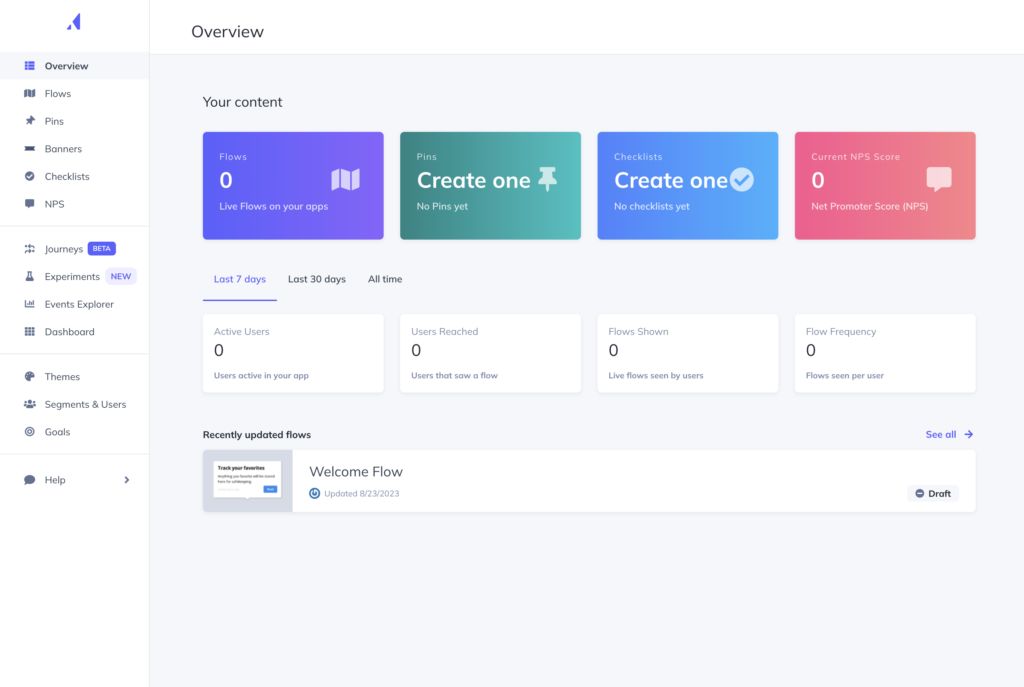
What is Chameleon?
Chameleon is a product adoption platform. It enables SaaS teams to leverage real-time user data to build beautiful on-brand experiences, improve user onboarding, and drive product-led growth.
In addition, it empowers product teams to create and manage dynamic in-product experiences. With Chameleon, SaaS teams can now create beautiful product tours that help, guide, and delight their users throughout their journey. All of these are possible without coding!
Appcues vs Chameleon for user onboarding
In this section of the article, we’re really going to compare Appcues vs Chameleon in terms of user onboarding. That way, we’ll be able to figure out which tool – Appcues or Chameleon – is the best option depending on your use case.
Appcues for user onboarding
Onboarding new users seamlessly is one of the primary use cases of Appcues. The platform offers a wide array of features to help you improve user activation, conversion, and retention.
Let’s take a closer look at how Appcues facilitates new user onboarding:
- Drag-and-drop builder: Appcues’s no-code builder lets you create personalized onboarding tours and checklists to assist and educate new users. You can customize UI patterns like hotspots, modals, slideouts, and tooltips to guide users.
- In-app user guides and product tours: You can use various UI patterns, such as hotspots and tooltips, to introduce new users to product features in a pre-defined sequence. Similarly, you can use checklists to guide users as they explore your app.
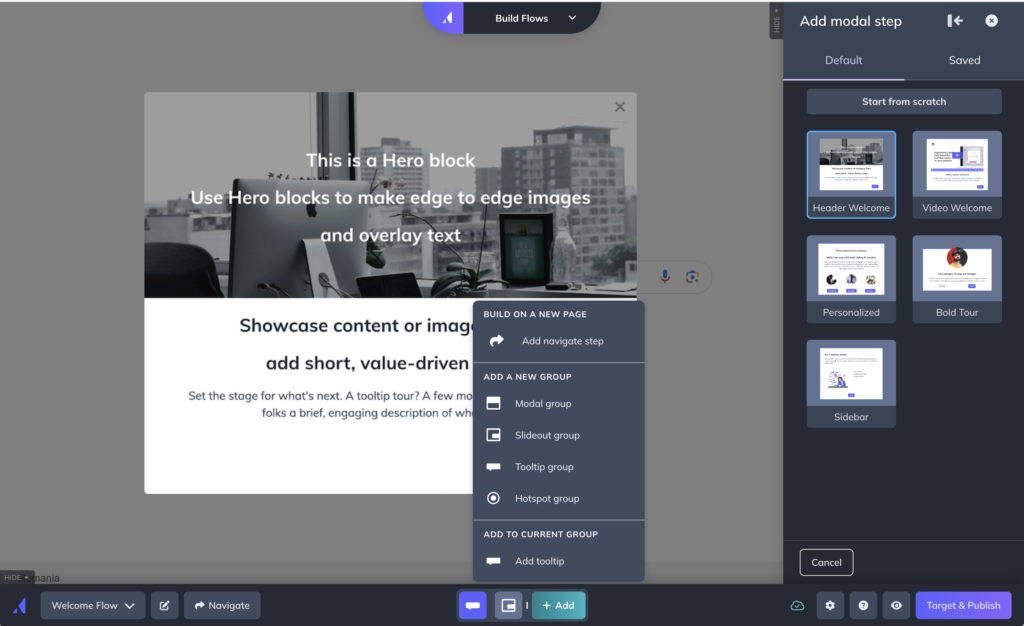
- Checklists: You can also create checklists with Appcues (NOT available on the Essentials plan) and prompt users to take action. These are ok but have limited functionality (you can’t trigger JS functions or add gamification elements) compared to alternatives, such as Userpilot.
- Segmentation: You can use one of the pre-defined audience segments or create customer segments based on plan tier, lifecycle stage, and other factors. It’s possible to target individual segments with personalized messaging and journeys.
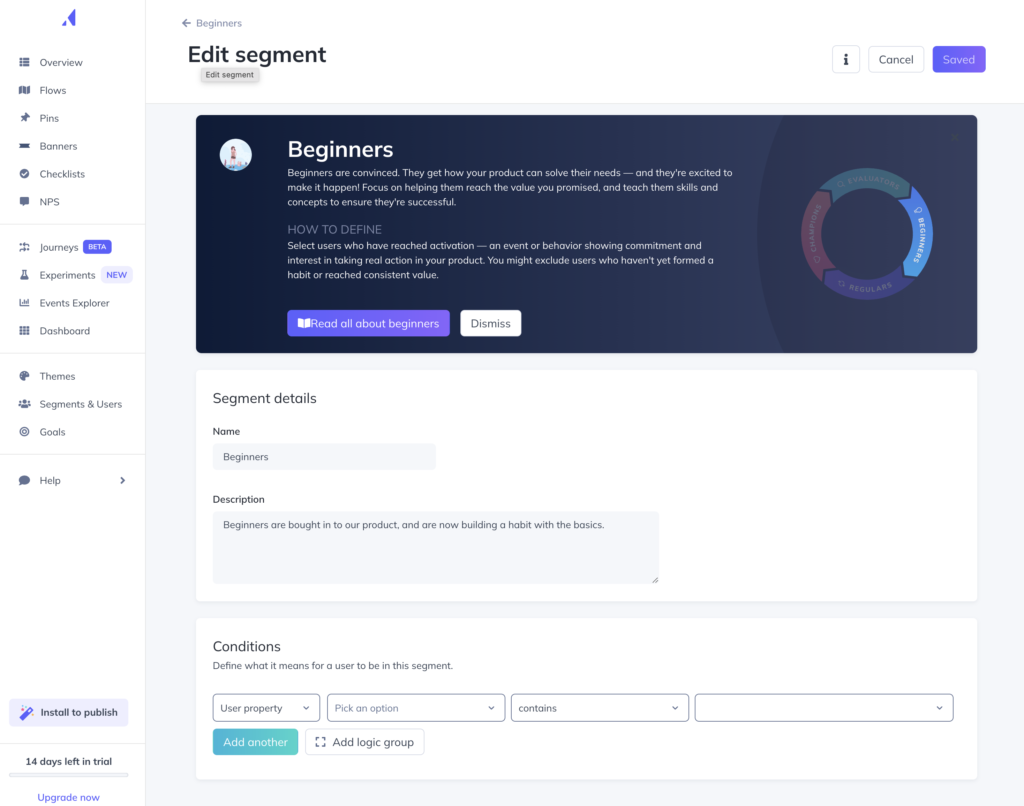
- Measure and improve: You can track in-app flow performance and measure events (limited to 5 on the Essentials plan) to identify areas of improvement.
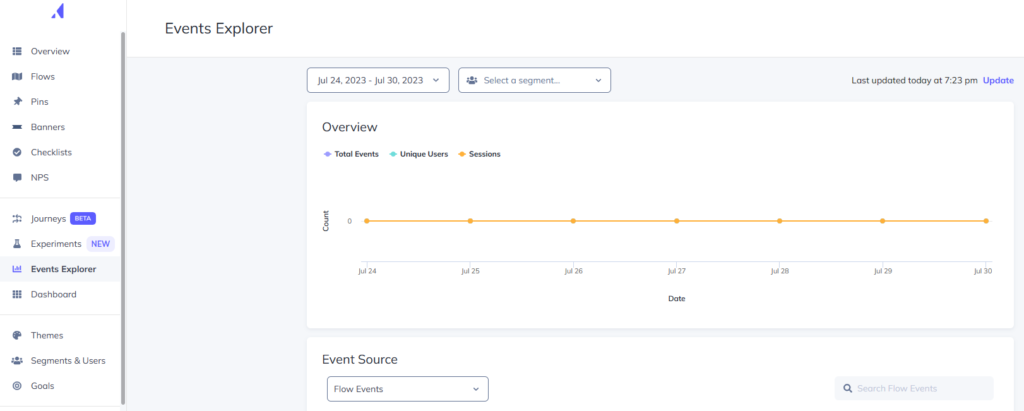
- Test and optimize: The newly introduced A/B testing feature lets you test different onboarding flows. You can compare the performance of different in-app sequences, identify the best-performing ones, and refine onboarding flows.
Chameleon for user onboarding
Users expect to be shown the red carpet with a welcome tour for your product. Chameleon helps you create welcome tours that gets users beyond their first “Aha”.
Here are some features of Chameleon for new user onboarding:
- Segmentation: You can use custom segments to show a sequence of your product tours over time. The hyper-targeted onboarding flows are tailored to your users’ needs. Here’s a short example of what the tour session can look like:
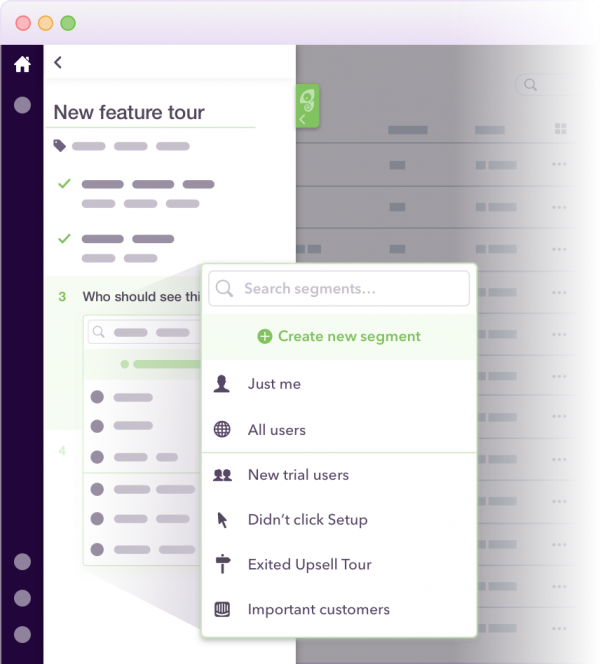
- Clear Analysis: Easily assess and optimize your user onboarding tours with real-time data.
- Launchers: Build onboarding checklists, including items like Loom videos and knowledge base articles to help users unlock more value.
- Customization options: Enjoy fine control over where the onboarding flow appears, choose who sees it, and define how users can interact with it.
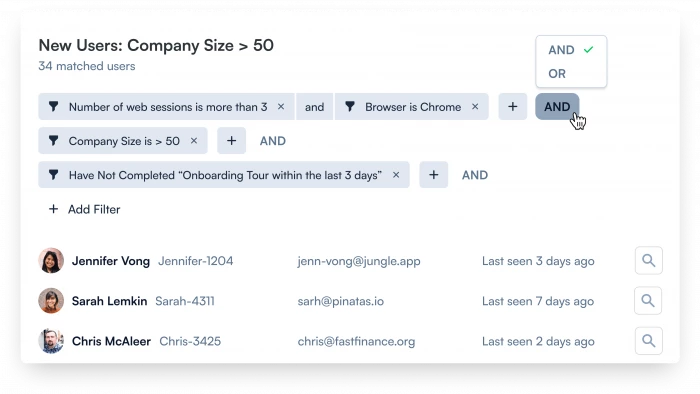
Spoiler alert: when you subscribe for the Starter plan, you get access to just one launcher which is very limited for many onboarding use cases. However, you get unlimited access when you pay an extra $971 for the Growth plan.
Appcues vs Chameleon for product adoption
In this section of the article, we’re really going to compare Appcues vs Chameleon in terms of product adoption. That way, we’ll be able to figure out which tool – Appcues or Chameleon – is the best option depending on your use case.
Appcues for product adoption
Appcues packs robust features to skyrocket free-to-paid conversions and drive upsells. Let’s take a closer look at how the platform facilitates product adoption.
- No-code builder: The no-code builder on Appcues lets you create onboarding flows that handhold users through your app. You can also use it to publish in-app announcements that draw a user’s attention to new features and upcoming events.
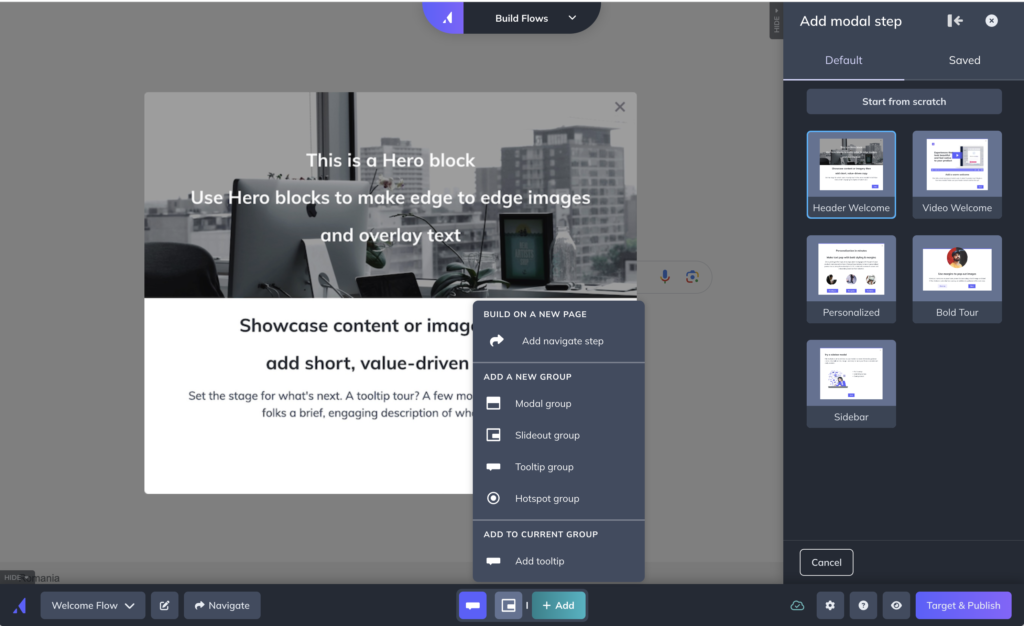
- Pre-designed templates: You can choose from many pre-made templates for each UI pattern. It’s easy to create product tours, in-app tutorials and announcements with these templates.
- Flow targeting: Appcues lets you segment users into different groups based on in-app activity, online behavior, and lifecycle stage. That makes it easier to customize your messaging and win over each segment, helping you convert trials into paying customers.
- Review prompts: Available on Appcues Mobile, this feature lets you nudge users to rate and review your app on various app stores at the right time. It can help drive new sign-ups as well.
- Other features, such as event tracking and A/B testing, can also help improve product adoption.
As you can see, Appcues is focused on in-app experiences but is limited by product analytics. Without proper data is hard to understand how your users are adopting your product and where they need help.
You can integrate Appcues with tools like Amplitude, but that comes at an additional cost. If you are looking for a product adoption tool, Appcues might not be the best.
Chameleon for product adoption
Users expect to be shown the red carpet with a welcome tour for your product. Chameleon helps you create welcome tours that gets users beyond their first “Aha”.
Here are some features of Chameleon for new user onboarding:
- Segmentation: You can use custom segments to show a sequence of your product tours over time. The hyper-targeted onboarding flows are tailored to your users’ needs. Here’s a short example of what the tour session can look like:

- Clear Analysis: Easily assess and optimize your user onboarding tours with real-time data.
- Launchers: Build onboarding checklists, including items like Loom videos and knowledge base articles to help users unlock more value.
- Customization options: Enjoy fine control over where the onboarding flow appears, choose who sees it, and define how users can interact with it.

Spoiler alert: when you subscribe for the Starter plan, you get access to just one launcher which is very limited for many onboarding use cases. However, you get unlimited access when you pay an extra $971 for the Growth plan.
Appcues vs Chameleon for customer experience
In this section of the article, we’re really going to compare Appcues vs Chameleon in terms of customer experience. That way, we’ll be able to figure out which tool – Appcues or Chameleon – is the best option depending on your use case.
Appcues for customer experience
Appcues plays a key role in taking your product’s customer experience (CX) up a notch.
It helps enhance CX in the following ways:
- UI patterns like checklists, hotspots, modals, and tooltips let you create guided in-app tours and tutorials and simplify customer onboarding.
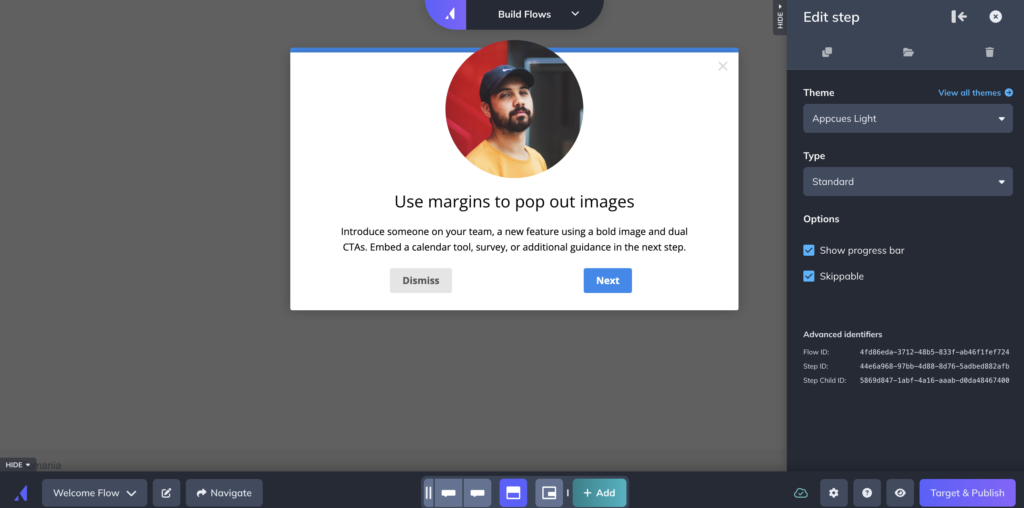
- A Launchpad lets users access Appcues onboarding flows from a notification dropdown within your product.
- NPS surveys help you collect customer feedback and improve your product. However, unlike Userpilot, Appcues only offers NPS surveys.
- Other features like user segmentation (for personalization) and event tracking also come in handy.
That said, Appcues alone can’t guarantee a flawless customer experience. It only covers the onboarding aspect of CX. You’ll need to focus on other aspects like customer support and relationship-building to improve the overall UX, and for those you need multiple types of user surveys, on-demand support (using a resource center) and proper analytics, which Appcues lack.
Chameleon for customer experience
Customer experience is the impression your customers have of your brand based on all of the interactions they’ve had with your business.
Chameleon improves the customer experience in product adoption through features like:
- In-app guidance: Utilizing product tours to improve customer experience. Note that you will need to have CSS knowledge to make styling changes in the Chameleon Builder.
- Personalization through segmentation: Chameleon offers you to personalize user experiences by tailoring product onboarding and in-app experiences for the users most prone to interact and be interested in them. But keep in mind that your segmentation filters are limited compared to other tools like Userpilot.
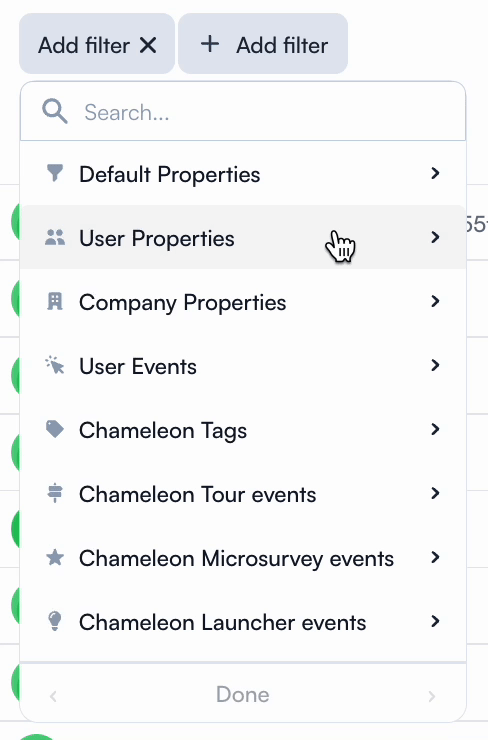
- User progress tracking: This feature enables you to identify areas where users might be facing difficulties or dropping off due to friction. By tracing user progress, you can scale their experience on your app.
Appcues vs Chameleon for user feedback
In this section of the article, we’re really going to compare Appcues vs Chameleon in terms of user feedback. That way, we’ll be able to figure out which tool – Appcues or Chameleon – is the best option depending on your use case.
Appcues for user feedback
Appcues provides a robust suite of tools to collect and analyze your product feedback for mobile apps. However, if you want to collect feedback for your web app, you only have access to an NPS survey.
Mobile app product feedback features include:
- Survey prompt asking a user to rate their experience of using a specific feature.
- Survey forms asking users about feature improvements or new features they’d like to see in your product.
- Collect and analyze NPS survey results to improve in-app experiences.
- App Store review prompts to encourage promoters to rate and review your product on leading app stores.
Chameleon for user feedback
Chameleon is a great product feedback tool for gathering contextual feedback inside your app and building an effective and actionable feedback loop.
With Chameleon, you can:
- Create various types of microsurveys: To measure user sentiment regarding new features, product UX and UI, or other in-app experiences created with Chameleon.
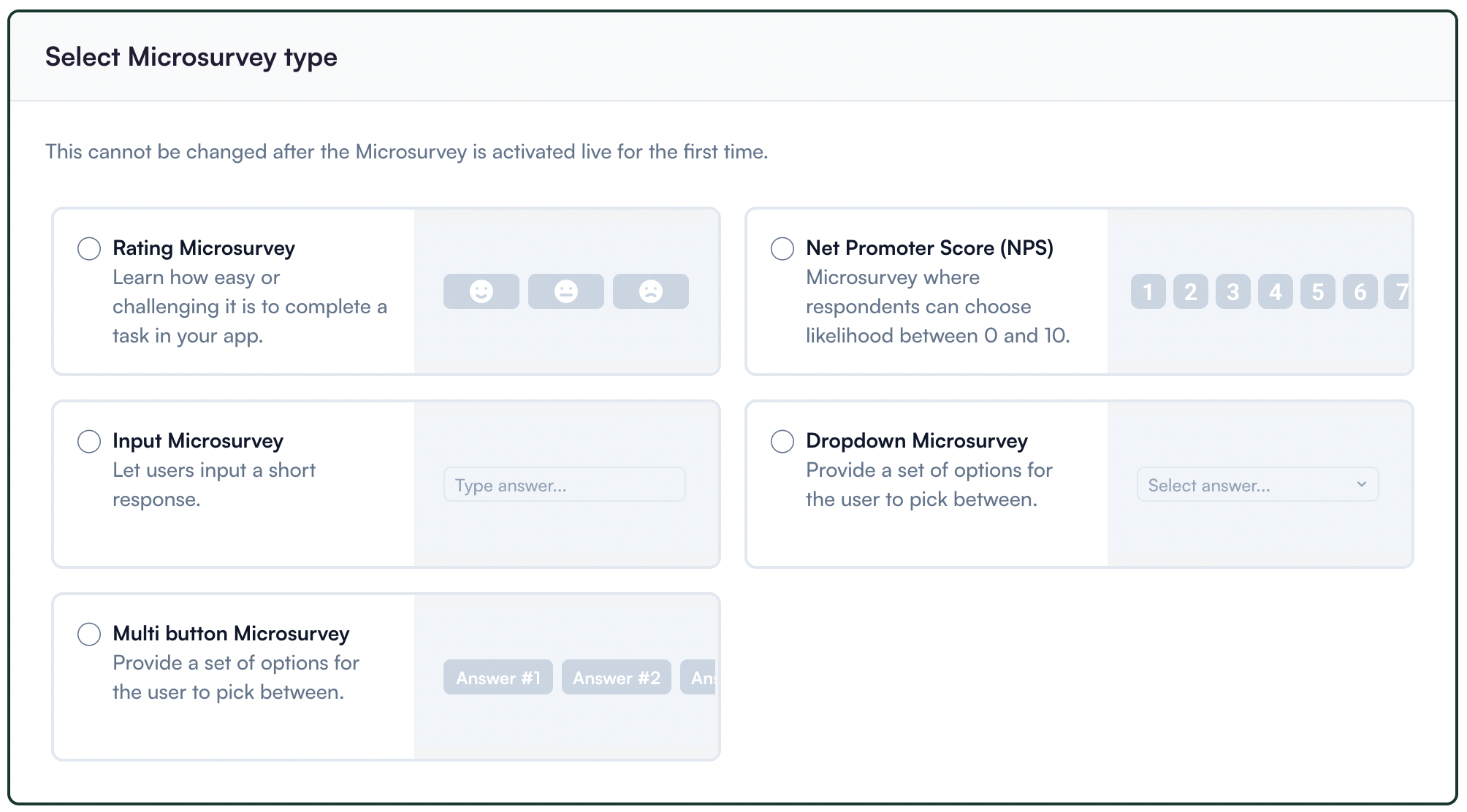
- Trigger feedback surveys: Target different custom segments for higher completion rates.
- You get access to basic completion reports: Most of the additional data will need to be analyzed in your analytics tools that Chameleon integrates with and sends data to.
- Personalize the surveys as you wish: You will need help from a developer or may require CSS skills.
Appcues vs Chameleon: Which one you should choose?
To further simplify this selection process, let’s break down the strengths and limitations of each tool. Understanding the distinct advantages and potential drawbacks of Appcues and Chameleon will provide you with a detailed roadmap for making a well-informed decision!
Pros and cons of Appcues
Pros of Appcues
As a first-comer in the no-code product adoption landscape, Appcues offers several valuable features. It’s suitable for mid-market SaaS businesses looking for a simple, easy-to-use tool that enhances user onboarding, retention, and the overall customer experience.
Let’s take a closer look at the benefits of Appcues:
- Intuitive UI and UX: Appcues offers a straightforward interface that’s easy to navigate and use. Users with non-technical backgrounds can design captivating in-app flows and onboarding journeys with its simple drag-and-drop builder. You can tailor user journeys with various UI patterns, from modals and hotspots to tooltips, slideouts, and banners.
- Simple setup: You can get started with Appcues in minutes by adding the SDK to your app’s source code or integrating Appcues with Segment or Google Tag Manager. Then, add a Chrome extension to launch the Appcues Builder in a few quick clicks and start creating in-app flows.
- Feedback options: Create Net Promoter Score (NPS) surveys to collect actionable user feedback. You can even check and analyze NPS analytics on your Appcues dashboard.
- Mobile onboarding: Besides web apps, you can use Appcues to create end-to-end experiences for mobile apps. It supports various mobile environments, including Native Android, Native iOS, React Native, Flutter, and Iconic.
- Extensive integrations: Appcues integrates with 20+ email automation, CRM, and analytics tools, including Heap, Zapier, HubSpot, Google Analytics, and Google Tag Manager. Many of these include two-way integrations.
Cons of Appcues
Appcues comes with a ton of useful features you’d expect from a leading product adoption platform, but it does have a few shortcomings.
Let’s look at a few drawbacks of Appcues:
- Poor element detection: The Appcues algorithm occasionally struggles to detect in-app elements, unlike some of its competitors like Userpilot. It’s particularly limiting when you want to add tooltips to individual options in a dropdown menu.
- Limited customization capabilities: While Appcues lets you customize pre-designed templates, you’re limited to basic options like font style, size, color, and padding. Advanced customization requires working with CSS code, which can be challenging for non-technical teams.
- Basic analytics: Appcues provides insights into product usage and customer behavior. However, you can’t access in-depth analytics without connecting to a third-party tool like Amplitude or Google Analytics.
- Limited survey options: Appcues lacks variety in feedback collection and survey options and doesn’t offer integrations with other platforms like Google Forms and Typeform. You can only build NPS surveys. This is in contrast to some of its competitors, like Userpilot, which offers an extensive library of customizable survey templates.
- Higher pricing: Starting at $249 per month, the Appcues Essential tier has several constraints, such as limited UI patterns and no custom CSS support. Moreover, localization support is only available in the Enterprise tier. If your app is multilingual, you’ll have to shell out a ton of money to make the most of Appcues.
- No live chat: While Appcues offers educational resources and a help center (Help Docs), customer support is limited to email and phone.
Appcues comes with a ton of useful features you’d expect from a leading product adoption platform, but it does have a few shortcomings.
Let’s look at a few drawbacks of Appcues:
- Poor element detection: The Appcues algorithm occasionally struggles to detect in-app elements, unlike some of its competitors like Userpilot. It’s particularly limiting when you want to add tooltips to individual options in a dropdown menu.
- Limited customization capabilities: While Appcues lets you customize pre-designed templates, you’re limited to basic options like font style, size, color, and padding. Advanced customization requires working with CSS code, which can be challenging for non-technical teams.
- Basic analytics: Appcues provides insights into product usage and customer behavior. However, you can’t access in-depth analytics without connecting to a third-party tool like Amplitude or Google Analytics.
- Limited survey options: Appcues lacks variety in feedback collection and survey options and doesn’t offer integrations with other platforms like Google Forms and Typeform. You can only build NPS surveys. This is in contrast to some of its competitors, like Userpilot, which offers an extensive library of customizable survey templates.
- Higher pricing: Starting at $249 per month, the Appcues Essential tier has several constraints, such as limited UI patterns and no custom CSS support. Moreover, localization support is only available in the Enterprise tier. If your app is multilingual, you’ll have to shell out a ton of money to make the most of Appcues.
- No live chat: While Appcues offers educational resources and a help center (Help Docs), customer support is limited to email and phone.
Pros and cons of Chameleon
Pros of Chameleon
From a wide array of features to aesthetic UI patterns that can create any flow no matter how customized they need to be, Chameleon is no doubt a powerful tool for scaling product adoption.
It works in a similar way to Userpilot and offers similar features: styling, analytics, templates, goals, A/B testing, and checklists.
Let’s look at the pros of using Chameleon:
- Intuitive no-code builder: Chameleon comes with an easy-to-use Chrome Extension builder.
- Engaging tour guides: Build interactive tours to onboard users, announce features, and create other customer in-product experiences using simple steps.
- Good range of in-app messaging and UI patterns: Easy to create custom modals, slide-outs, tooltips, hotspots, launchers (checklists or resource hub), and more.
- Full two-way and deep analytics integrations: Chameleon fits into your stack, and easily connects with your favorite tools to send data to, and from Chameleon. It offers the deepest integrations, with analytics tools, CRMs, and more.
- Effective segmentation and targeting system: Leverage user data and experiences to structure effective marketing messages and tour guides for a specific target audience.
- Advanced A/B testing: Drive continuous improvement of in-app messages and define the ideal user experience with precise A/B testing.
- Rate limiting: No user wants to be overwhelmed with multiple product tours, in-app messages, and tasks. With rate limiting, you can reduce the number of user experiences — one step at a time, with clarity over speed.
Cons of Chameleon
While Chameleon is a deep production adoption tool with an array of great features, there are still some downsides. Here are the main cons of the tool:
- Not entirely no-code: Early on, we stated that Chameleon can be used without code. True. But it is not a completely no-code tool. You’ll need the help of a technical-savvy employee in your team to sort out some build-up as the learning curve is steeper.
- Hard-to-use interface: The new UI is a bit harder to use (a lot of clicking), and there can be minor bugs here and there.
- Limited experiences: There are some limitations to the user onboarding flows. For instance, you can’t run multiple in-app experiences at the same time, as you can in Userpilot.
- Pricey: The Startup plan is quite expensive (starts at $349/mo for 2500 MAU and includes just one launcher). This means you need to go for the Growth plan, where you pay more but save more at the same time.
Userpilot – A better alternative for your SaaS
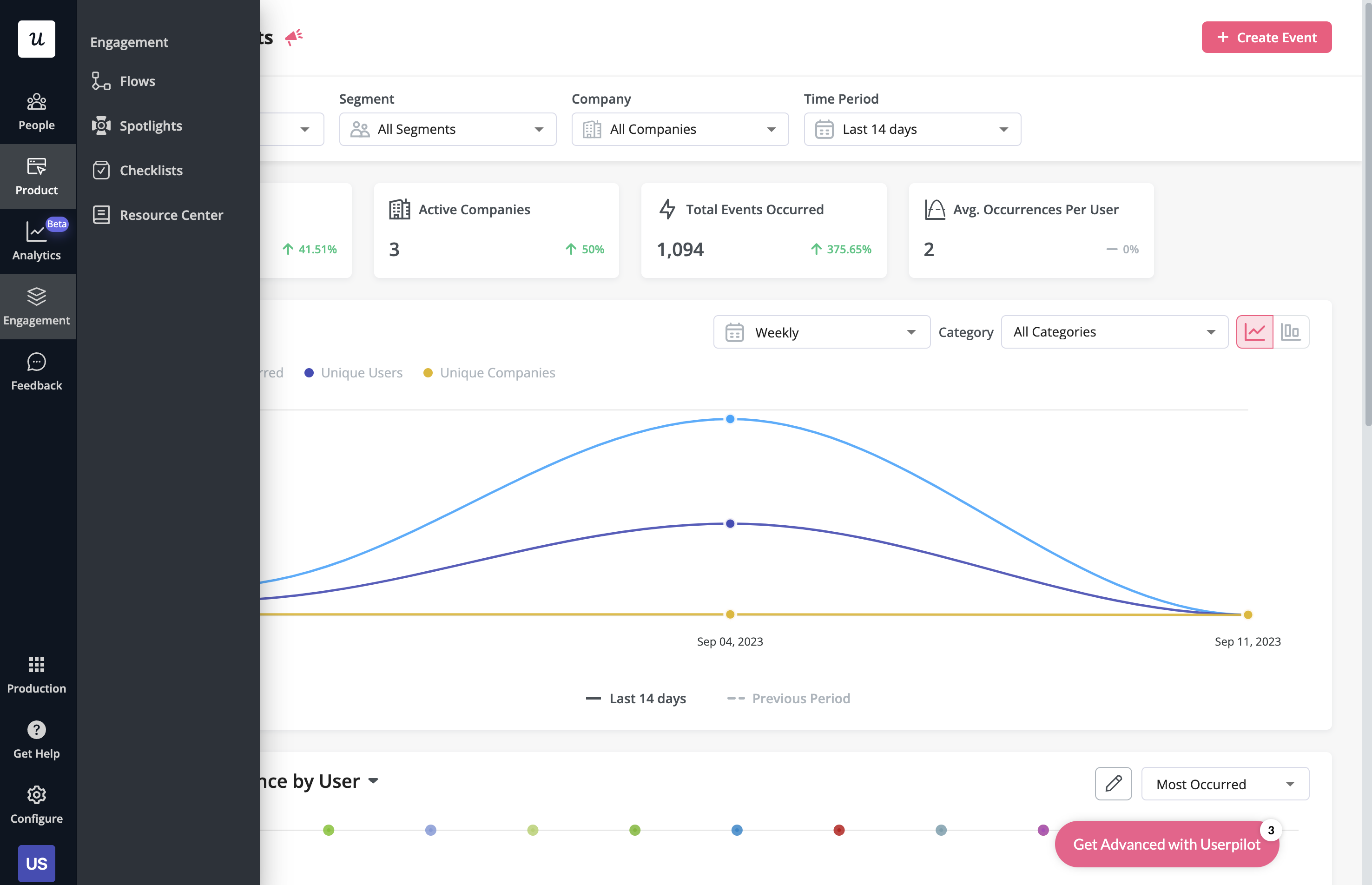 Userpilot is a product growth platform that drives user activation, feature adoption, and expansion revenue. It also helps product teams collect user feedback, streamline onboarding, and gather actionable insights from analytics.
Userpilot is a product growth platform that drives user activation, feature adoption, and expansion revenue. It also helps product teams collect user feedback, streamline onboarding, and gather actionable insights from analytics.
With Userpilot, you’ll be able to track both product usage and user behavior to get a holistic view of how customers use your product — which will guide future development, improve the user experience, and inform your growth efforts.
Pros of Userpilot
As a full-suite digital adoption platform, Userpilot has all the features you need to onboard users, track analytics, and gather feedback from customers without writing a single line of code. Here are a few pros of using Userpilot as your product growth solution:
- No-code builder: Userpilot’s Chrome extension lets you build flows, add UI elements, and tag features without writing a single line of code.
- UI patterns: There are plenty of UI patterns to choose from when using Userpilot, such as hotspots, tooltips, banners, slideouts, modals, and more!
- Startup-friendly: Userpilot’s entry-level plan gives you access to all available UI patterns so you can hit the ground running.
- Walkthroughs and flows: Build engaging interactive walkthroughs and personalized onboarding flows that target specific segments of your user base.
- Self-service support: Build an in-app resource center to help users solve problems, customize its appearance to align it with your brand, and insert various types of content (videos, flows, or chatbots) to keep your customers satisfied.
- A/B testing: Userpilot’s built-in A/B testing capabilities will help you split-test flows, iterate on the best-performing variants, and continually optimize based on user behavior.
- Feedback collection: Userpilot has built-in NPS surveys with its own unified analytics dashboard and response tagging to help you retarget users. There are other survey types to choose from and you can even create your own custom survey.
- Survey templates: There are 14 survey templates to choose from so you can gather feedback on specific features or run customer satisfaction benchmarking surveys like CSAT and CES.
- Advanced analytics: Userpilot lets you analyze product usage data, monitor engagement on all in-app flows, and use the data to create user segments that are based on behaviors instead of demographics.
- Event tracking: Userpilot’s no-code event tracking lets you tag UI interactions (hovers, clicks, or form fills) and group them into a custom event that reflects feature usage.
- Third-party integrations: Userpilot has built-in integrations with tools like Amplitude, Mixpanel, Kissmetrics, Segment, Heap, HubSpot, Intercom, Google Analytics, and Google Tag Manager so you can share data between all the solutions in your tech stack.
Cons of Userpilot
Of course, no tool is perfect and there are a few cons to consider before choosing Userpilot as your user onboarding or product growth solution:
- Employee onboarding: Currently, Userpilot only supports in-app customer onboarding.
- Mobile apps: Userpilot doesn’t have any mobile compatibility which could make it difficult for developers with cross-platform applications to create a consistent user experience for both versions of their product.
- Freemium plan: There’s no freemium Userpilot plan so those bootstrapping their startup and need sub-$100 solutions should consider more affordable onboarding platforms like UserGuiding or Product Fruits.
Conclusion
Hopefully, this post helped you decide whether Appcues or Chameleon is more appropriate for your company. As you can see – both have many upsides and downsides.
Undeniably, Userpilot provides a better value for money and is a better choice for a mid-market SaaS, especially when it comes to user onboarding and user feedback.
If you’re interested in finding more, book a demo with our team here!
![]()
Try Userpilot – The best user onboarding solution for SaaS


